A tale of two states
by B.C. Shama
While the Northern states of India have been wracked by Hindu-Muslim
conflicts, Tamil Nadu and Kerala in Southern India have not witnessed
Hindu-Muslim tension, leave alone riots.
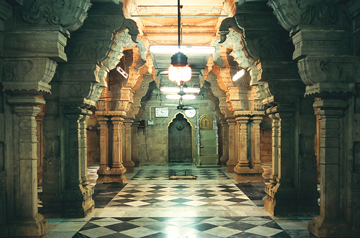
Kilakarai Jumma Mosque: One of the finest mosques to be built in
the Dravidian Islamic architecture by the legendary 17 Century
philanthropist, Seethakkathi at Kilakarai |
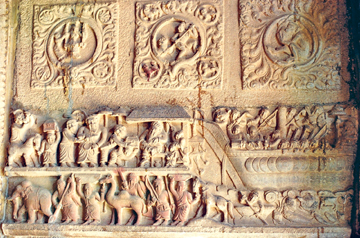 |
| A bas relief
sculpture depicting the maritime trade of the Muslims found at
the Azhagiya Nambi temple at Thirukurungudi |
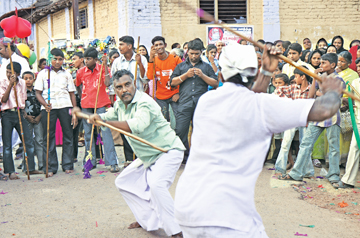 |
The Tamil
traditional martial art 'silambam' being exhibited by Tamil
Muslim men
|
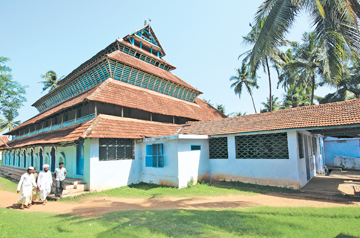 |
| Miskal Palli:
The mosque built in the architectural tradition of the Chera
country by an Arab trader at Calicut |
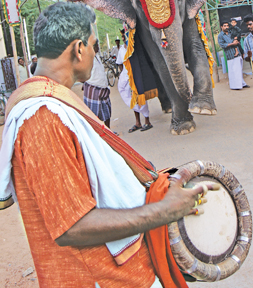 |
|
The Kandhuri celebrations
at Alwarthirunagari |
The Muslims came to the North as conquerors, and stayed on to be the
new ruling class. They had to maintain their hegemony through force of
arms. Although they imbibed Hindu cultural and linguistic forms and
imparted West Asian cultures and languages to the Hindus to form a
synthetic Indian or 'Hindustani' culture, the fact that they were the
ruling class for centuries before the British ousted them in the 19
Century has adversely affected Hindu-Muslim relations in North India.
The Muslims came to South India in an entirely different way: As
traders. They settled down to be a local trading class, specializing in
international maritime trade and being an intermediary between the South
Indian economy and the economies of West and East Asia. Between the
Chola era and the arrival of the Portuguese in the 15 Century, Muslims
were handling international maritime trade on behalf of the Tamil
kingdoms or chiefdoms in what is now known as Tamil Nadu and Kerala.
The historical and contemporary saga of Muslim-Tamil relations in
Tamil Nadu and Kerala, has been brought out in a fascinating documentary
film produced and directed by Kombai S.Anwar.
Place in economy
Entitled Yaadhum-A Tamil Muslim's Search For His Roots And Identity,
it has recently won a Bronze Remi award at the 48th WorldFest Houston
International Film Festival. Earlier, it was declared as the Best
Documentary Film for the year 2013 by the Tamil Nadu Progressive Writers
and Artists Association.
Anwar begins his journey from this home town, Kombai, in Theni
District, bordering Kerala. If Kombai had prospered since 1 AD, it was
because its pepper and cardamom were marketed worldwide by Arab maritime
traders.
Those days, the Arabs used to land at Muziri, now called Kodungalur,
40 km north of Kochi, in Kerala. Muziri was a major Tamil port since the
days of the Chera kings.
According to Anwar, the Arab traders called the South Western Indian
coast as "Mabaar" or "Transit point" as it was half way between West
Asian and East Asian ports. Perhaps the "Malabar" region of Kerala today
owes its origin to the Arabic word Mabaar. Given Kodungalur's position
historically, it is hardly surprising that India's oldest mosque - the
Cheraman Jumma Palli - built between 800 and 1100 AD, is in Kodungalur.
Kodungalur was a transshipment port even for Chinese vessels trading
with West Asia. The Chinese fishing nets used on the Kochi coast even
today, bear testimony to the East-West transshipment trade through
Kodungalur. The Muslim Maraikkar traders of Tamil Nadu, Kerala and Sri
Lanka, are so named, because they came by a Marakkalam or wooden boat.
The Muslims also specialized in wooden boat building. Even today, there
is a community of Muslims in Pulicat, north of Chennai, which
specializes in boat building. The Rowthers of Tamil Nadu were Arab
traders who brought horses to Southern India from Arabia. Till date, the
Rowthers are in shipping and trade.
The role of the Arab merchants in the economy of Tamil country in the
distant past finds mention in ancient Tamil Sangam literature.
Aganaanooru (149) talks of Yavana (Yemeni) ships bringing gold and
taking pepper back in exchange The Brihadeeshwara temple in Thanjavur in
Tamil Nadu, built by Rajaraja Chola I in 1010 AD, has inscriptions
mentioning the Arab currency, "Drammam" (Dirham).
Wealthy Muslim merchants have been witnesses to major land grants by
South Indian kings and chieftains. The 9th Century St.Therasa's copper
plate shows signatures of witnesses in three scripts including
Pahlavi-Kufi (Arabic).
Muslims had also occupied high office in the Tamil kingdoms. Anwar
mentions one Sonaka Saroor as a high official in the Chola kingdom. The
term Sonaka had come to be used for Tamil-speaking Muslims by the time
of the Cholas.
Muslim merchants were integrated into the Hindu caste structure in an
ingenious way. They were referred to as Anjuvannam or the fifth colour
(caste) in the Hindu varna (caste) system. The other four varnas (colours
or castes) being Brahmin, Kshatriya, Vaishya and Shudra. Anwar quotes
Prof.Y.Subbarayalu, to say that Tamil Nadu was dotted with Anjuvannam or
Muslim settlements.
Place in society and culture
Muslims had found a place in Hindu temples too. At the Vishnu temple
in Alwarthirunagari in Thirunelveli, a vessel with Arab traders on board
is depicted. In the Azhagiyanambi temple at Thirukurungudi in southern
Tamil Nadu, there is a bas relief sculpture showing an Arab trader
arriving by boat and landing a horse on the shore. The Rowthers of Tamil
Nadu were horse traders who brought Arabian horses to Tamil Nadu.
Islam was brought to Tamil Nadu, not only by Arab traders but also by
Sufi Saints from Syria, Turkey and Iraq. Uriyarur in Tiruchi became a
major Islamic centre a thousand years ago, thanks to the Sufi Saint
Nattar Wali.
When the 16 Century Sufi Saint, Shahul Hameed, cured Thanjavur ruler
Achutappa Naik of an ailment, land was granted to him at Nagoor where a
shrine was built. It later became a popular shrine attracting people of
all faiths, especially seafarers hoping for a safe journey across
treacherous oceans.
Today, in an era of fundamentalist Islam, there is a thriving
Hindu-Muslim syncretic culture in Tamil Nadu. In Alwarthirunagari in
Thirunelveli District of Tamil Nadu, the mosques use caparisoned
elephants and Nadaswaram musicians in their Sufi Kanduri processions.
Use of elephants and Nadaswaram music is typical of Hindu Kovil
festivals.
The Muslims of Tamil Nadu had adapted the Dravidian Hindu temple
architecture when building their mosques. The early mosques and also
ancient mosques still in use, have sculptured columns, though no humans
or animals are depicted as per the Islamic injunction.
In Kilakarai, the Seethakaadi mosque built in the 17 Century and the
Habib Arasar mosque built in the 19 Century, conform to the Dravidian
style with sculptured, multi-pillared prayer halls.
According to Dr.Raja Mohammad, in those days, there was no prescribed
architectural design for a mosque. Muslims built mosques as per the
local style for a place of worship. The documentary shows mosques in
Kerala which are built like the Hindu temples of Kerala.
Contribution to Tamil literature
The Muslims' contribution to Tamil literature has been outstanding
from the earliest times. Ayiram Masla (1000 questions or issues) about
Islam, written in 1590, was accepted in the highest Tamil literary
circles of Madurai. Kaviko Abul Rahman quotes K.A.P.Viswanatham to say
that from the stand point of religious groups' contribution to Tamil
literature, Islam's contribution has been the greatest. According to
Rahman, the Muslims had kept Tamil literature alive in the "dark age"
between the 16 and the 19 Centuries. The Muslims introduced to Tamil,
new literary styles like Kissa, Nama, Padaippor and Munajat. Muslims had
adopted local forms to express Islamic themes. The 16 Century Tamil
poem, Miharaj Malai, on the Prophet's ascent to Heaven, is sung in the
classical Carnatic style adhering to the Carnatic Raga patterns. In the
17 Century work, Seera Puranam, on the Prophet's life, Umaru Pulavar
uses South Indian imagery rather than the imagery of the West Asian
desert. |

